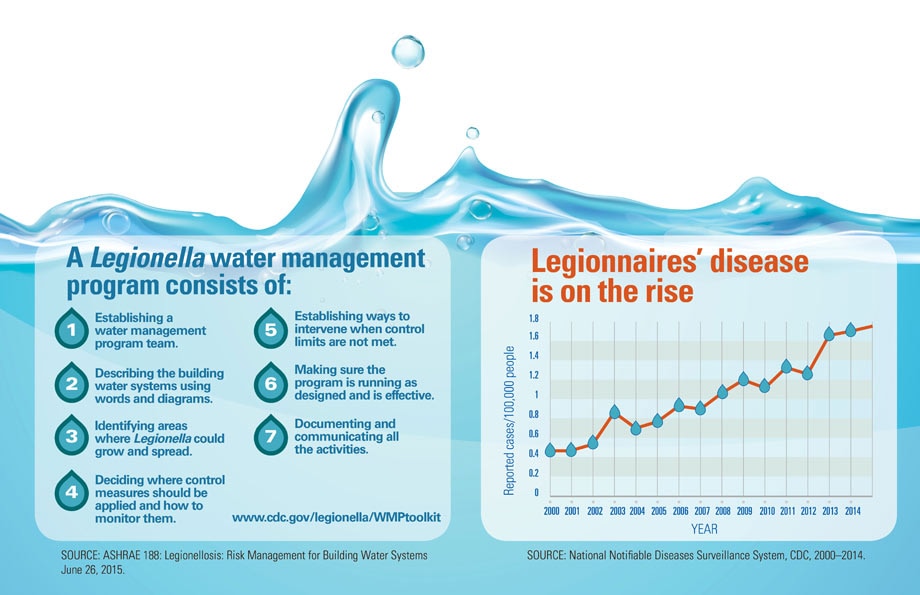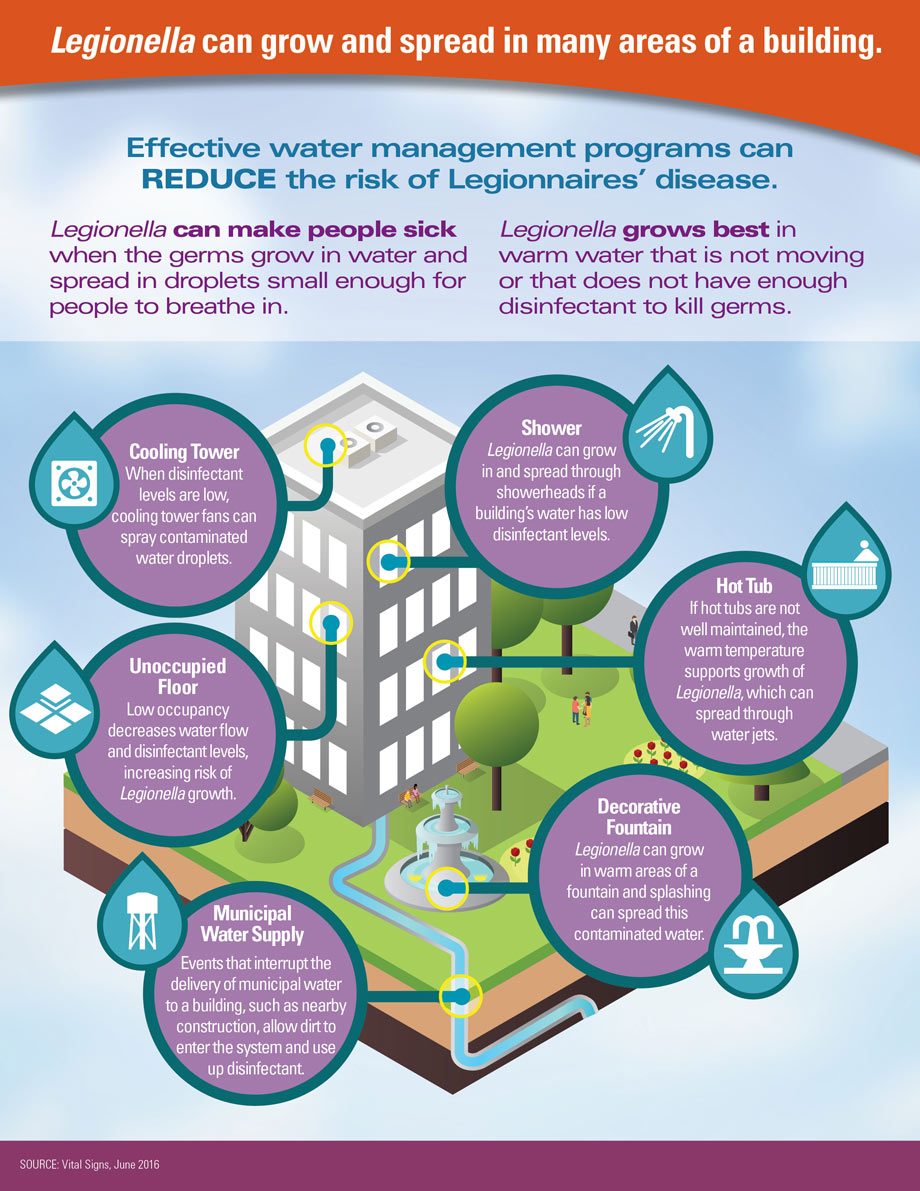Archive for the ‘Legionnaire’s Disease’ Category
Legionnaire’s in Queens
Thursday, October 26th, 2017Health Department Investigates Community Cluster of Legionnaires’ Disease in Downtown Flushing, Queens
12 confirmed cases of Legionnaires’ disease have been reported in the area in the past two weeks
Legionnaires’ disease cannot be spread from person to person; those at high risk include people aged 50 or older, especially cigarette smokers, people with chronic lung disease or with weakened immune systems
New Yorkers with respiratory symptoms, such as fever, cough, chills and muscle aches, are urged to promptly seek medical attention
October 24, 2017 — The Health Department is currently investigating a community cluster of Legionnaires’ disease cases in downtown Flushing, Queens. A total of 12 patients have been confirmed with Legionnaires’ disease in the area in the past two weeks. Most patients had serious underlying health conditions. The patients range in age from early 30s to late 80s. Five persons are hospitalized and recovering, and seven have been discharged from the hospital. No patients have died. Two more cases are currently being investigated to determine whether they are part of this cluster. The Health Department is actively investigating these cases and has taken water samples from all cooling tower systems within the investigation zone to test for Legionella, the bacteria that causes Legionnaires’ disease. To raise awareness in the community, the Health Department and the Mayor’s Office are working with elected officials and sending outreach teams to transit hubs and senior centers in the area to distribute information about Legionnaires’ disease. The Health Department is also organizing a community meeting to inform residents, answer questions and address any concerns. The Health Department is urging residents in the area with respiratory symptoms, such as fever, cough, chills and muscle aches, to promptly seek medical attention. The Health Department has alerted health care providers in the area about this cluster. Legionnaires’ disease is a treatable infection using antibiotics for pneumonia. Every year, there are between 200 and 400 cases of Legionnaires’ disease in the city.
As of today, the Health Department has sampled all cooling towers in the investigation zone. Testing involves a two-step process that first identifies genetic evidence of the bacteria and then confirms if the bacteria are alive and able to cause disease. Positive results from the first step will enable the Health Department to identify towers that potentially have bacteria capable of making people sick. The owners of those buildings will be ordered to immediately increase the level of biocides that kill the Legionella bacteria or to change to a new biocide and report to the Department within 24 hours. This biocide remediation will be done as a precautionary step while the second step, growing the bacteria in culture, is being done to determine the presence of the live bacteria that causes Legionnaires’ disease. It takes two weeks to allow bacteria adequate time to grow. A positive culture indicates the presence of bacteria capable of causing disease. The Department will order the owner of any building with a positive culture result to fully clean and disinfect the cooling tower.
“The Health Department is currently investigating a cluster of Legionnaires’ disease cases in the downtown Flushing area of Queens, and I urge individuals in this area with respiratory symptoms to seek medical attention right away. People over the age of 50 and people with compromised immune systems are especially at risk,” said Health Commissioner Dr. Mary T. Bassett. “As with our previous Legionnaires’ disease investigations, we are in the process of investigating the source of the cluster and are working with building owners in the area to rapidly test and clean cooling towers.”
Legionnaires’ disease is caused by the bacteria Legionella. Symptoms include fever, cough, chills, muscle aches, headache, fatigue, loss of appetite, confusion and diarrhea. Symptoms usually appear two to 10 days after significant exposure to Legionella bacteria. Most cases of Legionnaires’ disease can be traced to plumbing systems where conditions are favorable for Legionella growth, such as cooling towers, whirlpool spas, hot tubs, humidifiers, hot water tanks, and evaporative condensers of large air-conditioning systems.
Legionnaires’ disease cannot be spread from person to person. Groups at highest risk for Legionnaires’ disease include people who are middle-aged or older, especially cigarette smokers, people with chronic lung disease or weakened immune systems and people who take medicines that weaken their immune systems (immunosuppressive drugs). Those with symptoms should call their doctor and ask about testing for Legionnaires’ disease.
Local Law 77
In response to the Legionnaires’ disease outbreaks of 2015, the Mayor and City Council passed Local Law 77 to reduce and contain Legionella growth in cooling towers, becoming the first U.S. municipality to adopt a set of robust requirements to ensure cooling tower maintenance. Changes to the Health Code went into effect in May 2016. In June of last year, the Health Department announced a plan to reduce the risk of Legionnaires’ disease outbreaks in the city, which, in addition to implementing the most aggressive cooling tower regulation in the nation, included the hiring of more inspectors and training of City personnel to inspect towers and better capacity to conduct lab testing. Since the implementation of the new law, the Department has identified and monitored over 4,000 cooling tower systems (over 6,100 cooling towers) in New York City.
To promote compliance, the Health Department has been educating building owners and managers in best practices for managing their cooling towers. The agency has distributed information about the Management Program and Plan template, how to build a cooling tower system team and general Frequently Asked Questions.
For more information about Legionnaires’ disease, please visit the Health Department website.
###
#084-17
MEDIA CONTACT: Christopher Miller/Julien Martinez: (347) 396-4177
pressoffice@health.nyc.gov
Seven cases of Legionnaires’ disease have been reported in the last 11 days; 1 death
Tuesday, June 20th, 2017Health Department Investigating Community Cluster of Legionnaires’ Disease in Section of Lenox Hill in Manhattan
Seven cases of Legionnaires’ disease have been reported in the last 11 days
Legionnaires’ disease cannot be spread from person to person; those at high risk include people aged 50 or older, especially cigarette smokers, people with chronic lung disease or with weakened immune systems
New Yorkers with respiratory symptoms, such as fever, cough, chills and muscle aches, are urged to promptly seek medical attention
June 16, 2017 — The Health Department is currently investigating a community cluster of Legionnaires’ disease in a section of Lenox Hill in Manhattan. A total of seven individuals have been confirmed with Legionnaires’ disease in the last 11 days. Four persons are hospitalized and recovering, two have been discharged from the hospital and one person with significant underlying health conditions in their 90s has died. The Health Department is actively investigating these cases and has sampled and is testing water from all cooling tower systems within a half kilometer radius of this section of Lenox Hill. New Yorkers with respiratory symptoms, such as fever, cough, chills and muscle aches, are urged to promptly seek medical attention. The Health Department has alerted health care providers in the area. Legionnaires’ disease is treatable with standard antibiotics used to treat pneumonia. Every year, there are between 200 and 400 cases of Legionnaires’ disease in the city.
“The Health Department has identified an increase and cluster of Legionnaires’ disease cases in the Lenox Hill area,” said Health Commissioner Dr. Mary T. Bassett. “We have begun an investigation to determine the source of the cluster, focusing on cooling towers in the neighborhood. I urge individuals in this area with respiratory symptoms to seek medical attention right away.”
“Residents should be looking out for signs of Legionnaires: anybody with fever, cough, chills and muscle aches, should quickly see medical attention,” said Council Member Ben Kallos. “We are working with the Department of Health and Mental Hygiene to identify the source immediately. My thoughts and prayers are with the family of the individual who passed away.”
Legionnaires’ disease is caused by the bacteria Legionella. Symptoms include fever, cough, chills, muscle aches, headache, fatigue, loss of appetite, confusion and diarrhea. Symptoms usually appear two to 10 days after significant exposure to Legionella bacteria. Most cases of Legionnaires’ disease can be traced to plumbing systems where conditions are favorable for Legionella growth, such as cooling towers, whirlpool spas, hot tubs, humidifiers, hot water tanks, and evaporative condensers of large air-conditioning systems.
Legionnaires’ disease cannot be spread from person to person. Groups at highest risk for Legionnaire’s disease include people who are middle-aged or older, especially cigarette smokers, people with chronic lung disease or weakened immune systems and people who take medicines that weaken their immune systems (immunosuppressive drugs). Those with symptoms should call their doctor and ask about testing for Legionnaire’s disease.
Local Law 77
In response to the Legionnaires’ disease outbreaks of 2015, the Mayor and City Council passed Local Law 77 to reduce and contain Legionella growth in cooling towers, becoming the first U.S. municipality to adopt a set of robust requirements to ensure cooling tower maintenance. Changes to the Health Code went into effect in May 2016. In June of last year, the Health Department announced a plan to reduce the risk of Legionnaires’ disease outbreaks in the city, which, in addition to implementing the most aggressive cooling tower regulation in the nation, included the hiring of more inspectors and training of City personnel to inspect towers and enhanced capacity to conduct lab testing. Since the implementation of the new law, the Department has identified and monitored over 4,000 cooling tower systems (over 6,100 cooling towers) in New York City.
To promote compliance, the Health Department has been educating building owners and managers in best practices for managing their cooling towers. The agency has distributed information about the Management Program and Plan template, how to build a cooling tower system team and general Frequently Asked Questions.
For more information about Legionnaires’ disease, please visit the Health Department website.
###
Legionnaires’ disease kills 25% of those who get it from a health care facility.
Thursday, June 8th, 2017Overview
Legionnaires’ disease (LD) is a serious, and often deadly, lung infection (pneumonia). People usually get it by breathing in water droplets containing Legionella germs. People can also get it if contaminated water accidentally goes into the lungs while drinking. Many people being treated at health care facilities, including long-term care facilities and hospitals, have conditions that put them at greater risk of getting sick and dying from LD. Legionella grows best in buildings with large water systems that are not managed effectively. CDC outbreak investigations show that effective water management programs—actions that reduce the risk of Legionella growing and spreading in building water systems—can help prevent problems that lead to LD. Health care facility leaders* should be aware that LD is a risk in their facility and that they can take action to prevent infections.
Health care facility leaders can
- Build a team focused on keeping their facility’s water safe.
- Create and use a water management program to limit Legionella and other waterborne germs from growing and spreading. cdc.gov/legionella/WMPtoolkit
- Work with healthcare providers to identify LD cases early and determine if the cases may be associated with a health care facility.
- Report LD cases to local public health authorities quickly and work with them to investigate and prevent additional cases.
*Leaders may include infection control practitioners, facility managers, hospital administrators, quality assurance staff, or others.
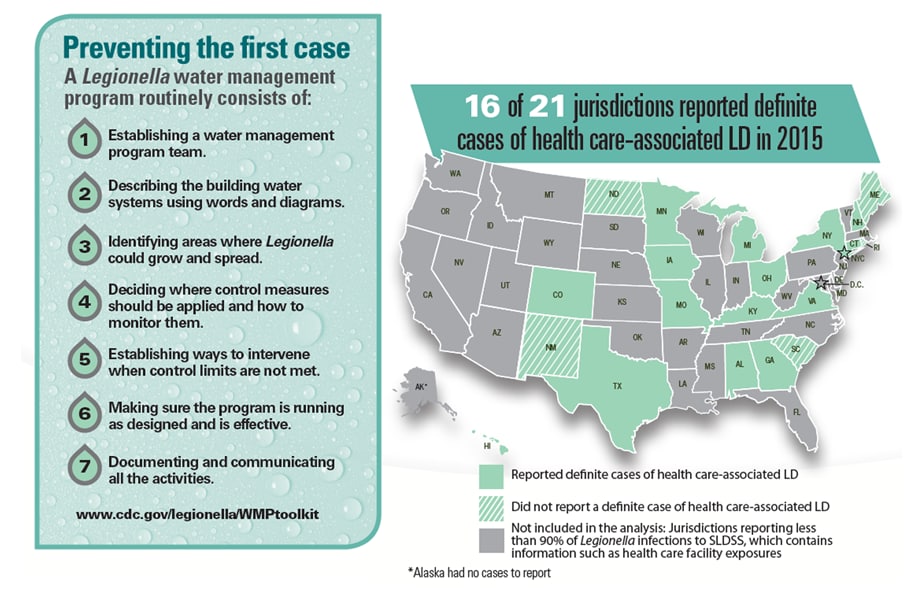
Problem
Legionnaires’ disease can occur in your health care facility
Health care facilities may put people at risk for LD when they do not have an effective water management program. These limit germ growth by:
- Keeping hot water temperatures high enough.
- Making sure disinfectant amounts are right.
- Keeping water flowing (preventing stagnation).
- Operating and maintaining equipment to prevent slime (biofilm), organic debris, and corrosion.
- Monitoring factors external to buildings, such as construction, water main breaks, and changes in municipal water quality.
Contaminated water droplets can be spread by:
- Showerheads and sink faucets.
- Hydrotherapy equipment, such as jetted therapy baths.
- Medical equipment, such as respiratory machines, bronchoscopes, and heater-cooler units.
- Ice machines.
- Cooling towers (parts of large air-conditioning systems).
- Decorative fountains and water features.
Health care facility leaders and providers should be aware that some people are at increased risk for LD:
- Adults 50 years or older.
- Current or former smokers.
- People with a weakened immune system or chronic disease.
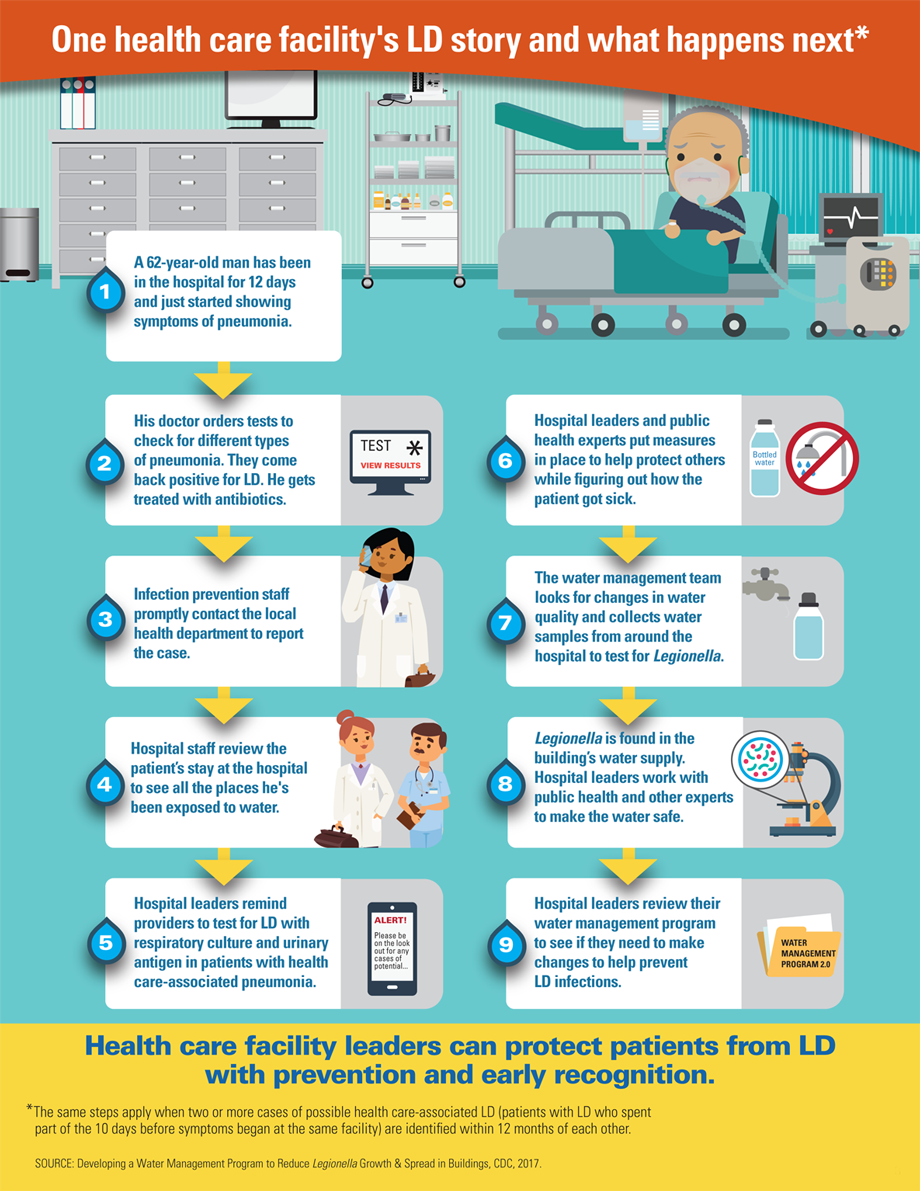
Lithuania: An emergency has been declared in the capital city of Vilnius after Legionella bacteria were found in the water systems of several apartment buildings.
Wednesday, March 15th, 2017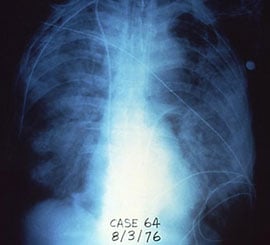
Legionellosis is bacterial respiratory disease caused by Legionella that can present as either Legionnaires’ disease or Pontiac fever. Legionnaires’ disease is a common cause of severe pneumonia requiring hospitalization, while Pontiac fever generally resolves on its own.
The following table summarizes key clinical differences between Legionnaires’ disease and Pontiac fever.
| Legionnaires’ disease | ||
|---|---|---|
| Clinical features | Pneumonia, cough, fever | |
| Pathogenesis | Replication of organism | |
| Radiographic pneumonia | Yes | |
| Incubation period | 2 to 10* days after exposure | |
| Percent of persons who become ill, when exposed to the source of an outbreak |
Less than 5% | |
| Isolation of organism | Possible | |
| Outcome | Hospitalization common Case-fatality rate: 10%, approximately 30% for healthcare-associated cases |
Minnesota health officials have confirmed 3 new cases of Legionnaires’ disease linked to the ongoing Hopkins outbreak, bringing the total number to 20, including one death.
Friday, September 30th, 2016
Fast Facts
- Legionella can cause Legionnaires’ disease or Pontiac fever, collectively known as legionellosis.
- The bacterium was named after an outbreak in 1976, when many people who went to a Philadelphia convention of the American Legion got sick with pneumonia (lung infection).
- About 5,000 cases of Legionnaires’ disease are now reported each year in the United States. [1]
- About one out of every 10 people who get sick from Legionnaires’ disease will die. [2]
- People can get Legionnaires’ disease or Pontiac fever when they breathe in a mist (small droplets of water in the air) that has been contaminated with Legionella.
- In general, Legionnaires’ disease is not spread from one person to another. However, this may be possible in rare cases. [2]
- Legionella is found naturally in fresh water environments, like lakes and streams, but can become a health concern in human-made water systems.
- Keeping Legionella out of water systems in buildings is key to preventing infection.
CDC: The number of people with Legionnaires’ disease grew by nearly 4 times from 2000–2014.
Wednesday, June 8th, 2016Legionnaires’ disease is deadly for about 10% of people who get it.
9 in 10. CDC investigations show almost all outbreaks were caused by problems preventable with more effective water management.
CDC investigated the first outbreak of Legionnaires’ disease, a serious lung infection (pneumonia), in 1976. An increasing number of people in the US are getting this disease, which is caused by breathing in small water droplets contaminated with Legionella germs. About 5,000 people are diagnosed with Legionnaires’ disease and there are at least 20 outbreaks reported each year. Most identified outbreaks are in buildings with large water systems, such as hotels, long-term care facilities, and hospitals. Legionella grows best in building water systems that are not well maintained. Building owners and managers should adopt newly published standards that promote Legionella water management programs, which are ways to reduce the risk of this germ in building water systems.
